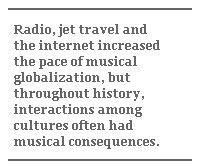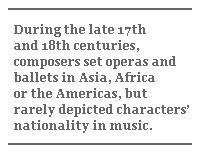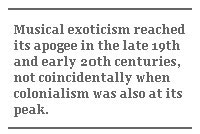Music Marches to Globalization’s Drum
Music Marches to Globalization’s Drum

NEW HAVEN: Nowadays nearly every music retailer – from the old fashioned bricks-and-mortar kind, through the online CD vendors, to the completely virtual iTunes Music Store – has a major section called “World Music” or “International.” The music in such categories typically encompasses the traditional musics of Asia, Africa and Latin America, as well as hybrids that blend indigenous music with techniques taken from hip hop, rock or jazz. Purists may regard such Western influence as contamination, but trans-continental cross-fertilization has produced remarkable results; indeed, jazz itself is an American product that draws on both African and European sources.
In recent decades, European classical music has become conspicuously global as well. Yo-Yo Ma, perhaps the most famous and charismatic classical musician of our era, is a Paris-born Chinese-American who often performs with musicians from the “Silk Road” of Central Asia. Most major orchestras have numerous Asian or Asian-American members, and any list of leading conductors would include Seiji Ozawa, born to Japanese parents in Manchuria, and Zubin Mehta, a Parsee from India.

The radio, the jet plane and the internet have increased the pace of musical globalization, but throughout history, interactions among cultures – in the form of exploration, trade, evangelization, migration or war – have often had musical consequences. Because European classical music has been preserved in written form for centuries, we have an abundance of evidence regarding the European perspective. Early examples of interactions tend to be isolated novelties, such as “Thule, the Period of Cosmography,” a poem set to music by Thomas Weelkes (1600); it rapidly mentions an assortment of exotic locales and topics, including Iceland, Mount Etna, Tierra del Fuego and Spanish commerce in Asian goods.
During the late 17th and 18th centuries, composers such as Purcell, Rameau and Gluck set numerous operas and ballets in Asia, Africa or the Americas. These works could feature colorful sets and costumes, but their composers generally employed the same musical techniques used for purely European plots; they rarely tried to depict the nationality of their characters in music. The librettos, too, were surprisingly conventional, concentrating on the same high-minded conflicts between love and duty among high-born characters found in serious operas based on European stories, themselves usually drawn from mythology or ancient history and thus equally remote from ordinary experience. The “exotic” qualities in these examples depend on words and stagecraft; someone who listened to a recording and didn’t understand the language probably wouldn’t recognize anything unusual.

But this soon changed. In the latter part of the 18th century, European armies gained the upper hand in their long conflict with the Ottoman Empire. Austrian forces occupied territory that had been under Ottoman control, and after centuries of fearing the Turks, Europeans began to view them instead as delightfully exotic, or even buffoonish. In the 1770s and ’80s “Turkish music” came into vogue; it typically featured instruments such as bass drums, triangles, cymbals and piccolos and techniques associated with Turkish military bands. Sometimes the musicians wore special costumes. Composers wrote operas with Turkish characters – Mozart’s “The Abduction from the Seraglio” (1782) is the most famous example – but now they had the means to depict another nationality in the music itself. Moreover, they frequently adopted elements of this style in purely instrumental works such as symphonies, concertos and sonatas. Several of these pieces remain popular today; for example, the last movement of Mozart’s Piano Sonata, K. 331, can be found not only in the concert hall, but also in movies, TV shows and street performances. The “alla turca” style may have had only a distant resemblance to genuine Turkish music, but its advent marked a turning point in music history, setting precedents for European versions of many national styles.

Musical exoticism reached its apogee in the late 19th and early 20th centuries, not coincidentally when colonialism was also at its peak; European composers produced countless instrumental and vocal pieces that vividly evoked various non-European peoples. Few of these composers traveled outside of Europe. Some gained their knowledge directly from foreign musicians, such as those who performed at the World’s Fair in Paris in 1889, but more often they drew on secondary sources. They borrowed folk songs, sometimes from published anthologies, and they devised ways to represent each nationality with a handful of techniques – particular rhythms, scales, chord progressions, instruments and so on – regarded as characteristic of its indigenous music. The toolbox they developed lived on in the movies, as Hollywood composers brought these sounds to a larger audience. Some works from this period – such as Puccini’s “Madama Butterfly” (1904), set in Japan, and “Turandot,” premiered posthumously in 1926, with its story of the Chinese imperial court – remain cornerstones of the repertoire to this day. On stage, non-European characters took many forms – they could be ruthless villains, innocent victims or alluring seductresses – but they usually stood out in their sheer otherness. Some of these characterizations now seem racist, but surprisingly often the audience was meant to sympathize with “exotic” characters rather than their Western counterparts; for example the heroine of “Madama Butterfly” is a Japanese woman seduced and abandoned by a callous American naval officer.
The golden age of exoticism coincided with the high tide of musical nationalism, when composers from Western nations considered outside of the musical “mainstream” – previously dominated by Germany, France, and Italy – self-consciously sought to create new musical traditions for their homelands. Russians, Spaniards, Finns, Bohemians and Americans displayed their patriotism with methods strikingly similar to those used in exotic music. They injected folk songs, dance rhythms and other distinctive features of their own indigenous music into symphonies and operas. Exoticism and nationalism might seem like opposites, but composers turned to both as sources of colorful new sounds that would set them apart from the usual repertoire.

The gap between the colonizers and the colonized diminished markedly in the late 20th and early 21st centuries. Western composers traveled to Indonesia to study Balinese gamelan music or to West Africa to learn polyrhythmic drumming, even as East Asian musicians flocked to American and European conservatories. The composer Tan Dun is a striking example of this trend. Growing up in China at a time when Western music was banned, he studied instead the traditional music permitted by the Communist Party. After the Cultural Revolution ended, he continued his education at the Beijing Conservatory and later at Columbia University. Remaining in the US, he has achieved extraordinary success with music that blends elements of both East and West. His film score for “Crouching Tiger, Hidden Dragon” won an Oscar in 2001, and on December 21, 2006, the Metropolitan Opera premiered “The First Emperor,” an opera based on the story of Qin Shi Huangdi, who unified China and began construction of the Great Wall more than 2200 years ago.
Tan Dun epitomizes the cross-cultural musicians of the 21st century, but it took a new technology to make “The First Emperor” a truly global event; on January 13, 2007, a live performance from Lincoln Center was beamed in High Definition to listeners around the world, in 100 theaters from Norway to Japan.
Richard Boursy, the archivist at Yale’s Gilmore Music Library, holds a Ph.D. in music history from Yale. He invites interested readers to look into the writings of scholars such as Ralph P. Locke, Miriam K. Whaples, Michael V. Pisani, and Jonathan Bellman, who have explored this topic in depth.